If there’s one thing we Americans have a lot of, it’s meal options. Stores these days are bursting with variety. The typical grocer carries 40 to 50 thousand items on average!
Long-term foods are no exception. There are tons of options out there for stocking up and you can get lost pretty quickly if you don't know what to look for.
In today’s post we’re going to help make shopping a lot easier with an in-depth look at two of the most popular places to go for disaster storage: grocery stores and emergency food suppliers.
We’ll lay out the most important things to look for when you’re shopping for long-term foods. Then we'll do a side-by-side comparison to see how grocery and emergency store products stack up—so next time you’re on the hunt for emergency food you’ll know what to look for!
First things first—water-removed foods
There are lots of foods with surprisingly long shelf lives. Canned items, spaghetti sauce, peanut butter (just to name a few) are all famous for lasting well beyond their expiration dates.
Here’s the problem, though. For the most part, even long-lasting products have some form of water or oil inside. And when water and oil get into your foods, watch out! They end up looking like this:

Yuck.
Your best bet for long shelf life is to look for foods that have their moisture removed. And by far, the two most effective methods for doing that are dehydration and freeze drying.
DEHYDRATION: Simply put, dehydration removes water via evaporation. Hot air is introduced into a chamber containing food till liquid becomes gas and floats away. Voila!
FREEZE DRYING: This method’s a little more space-age than dehydration, and it’s actually even more effective. Food is flash frozen and placed in a vacuum. In that environment, ice skips the liquid phase and turns right into vapor.
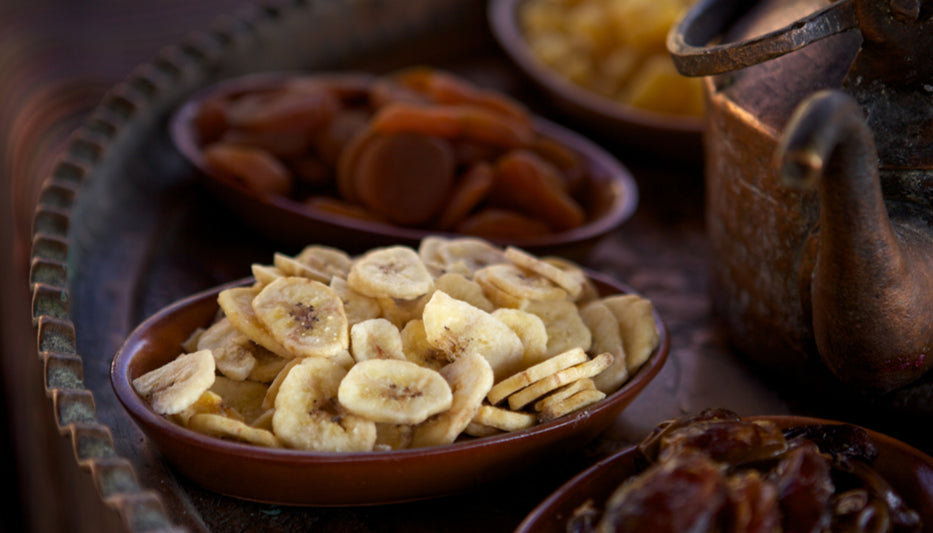
This is process is called sublimation. It gets rid 98 percent of water and does very little damage to cells, which means food holds on to its taste and nutritional value.
SHOPPING FOR DEHYDRATED & FREEZE-DRIED FOODS
Dehydrated and freeze-dried foods are super easy to find. Emergency suppliers carry them by the hundreds, and even grocery stores keep plenty in stock.
Here's a listing for freeze-dried foods at one popular big box store. This search alone brought up over 100 results.
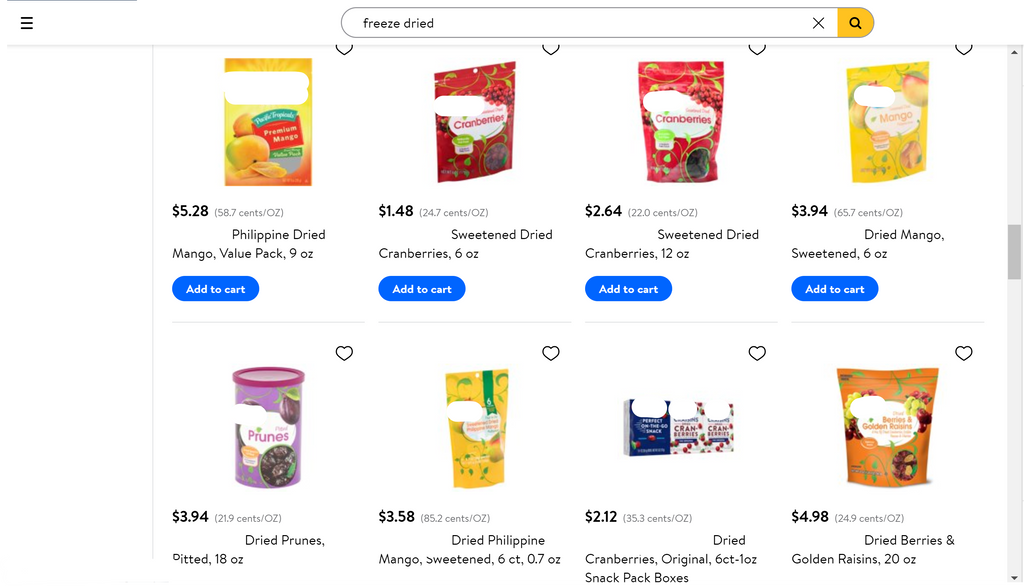
Next up—look for foods protected from outside threats
This is why it's so important to look for products that protect not just from the inside, but from outside threats as well.
The biggest threat to long-term foods is oxygen, so you want to make sure anything you pick up for your supply contains an oxygen absorber. These simple little pouches use iron powder to absorb the oxygen in a sealed package. And without oxygen to spoil it, freeze-dried and dehydrate foods inside can last even longer.
But how many of foods actually come with oxygen absorbers?
To answer this question, we headed to a popular big box store and picked up some freeze dried and dehydrated foods ourselves (field trip!). We took them home and tried them out side-by-side with Ready Hour emergency food, one of the brands we sell at BePrepared.com.
Here’s what we found
FREEZE-DRIED FOODS: GROCERY VS. EMERGENCY STORE
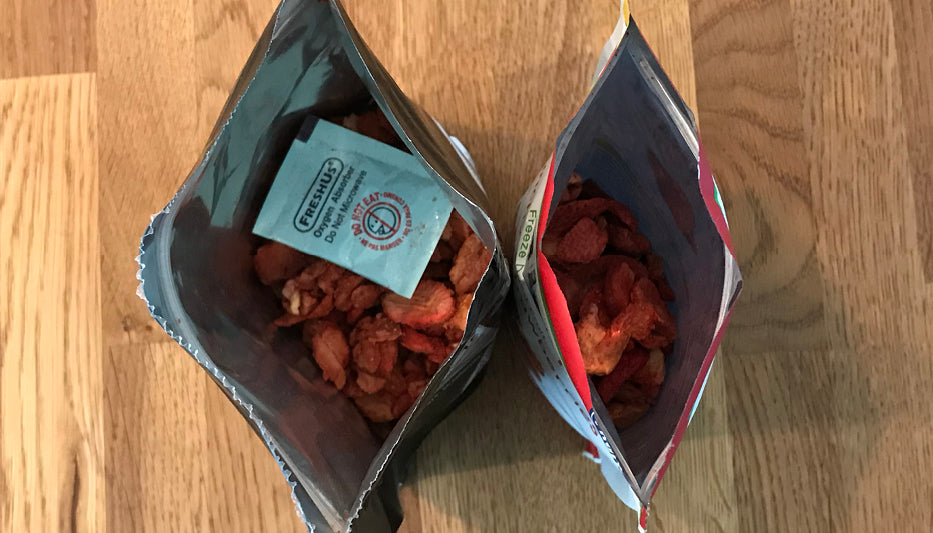
At the big box store, we chose freeze-dried strawberries from a well-known brand you’ll find most everywhere (pictured above on the right, alongside a Ready Hour strawberry package). As you can see, there’s no oxygen absorber in the grocery store strawberries.

The grocery store strawberries were purchased on August 10, 2020 with a “best-by” date of January 3, 2021, giving them less than a year shelf life. That's in part is due to the fact that they were sold almost a year after the production date. Either way, you're not getting much more than that out of them. This is pretty typical of most freeze-dried foods that aren’t adequately protected against oxygen.
And even though lots of grocery store foods like these can last a year or two beyond their shelf life, we don't recommend counting on that in an emergency.

In this picture you see a comparable Ready Hour Strawberry pouch. There's the oxygen absorber, right in the package. That’s one of the reasons it has a 25-year shelf life.
DEHYDRATED FOODS: GROCERY VS. EMERGENCY STORE
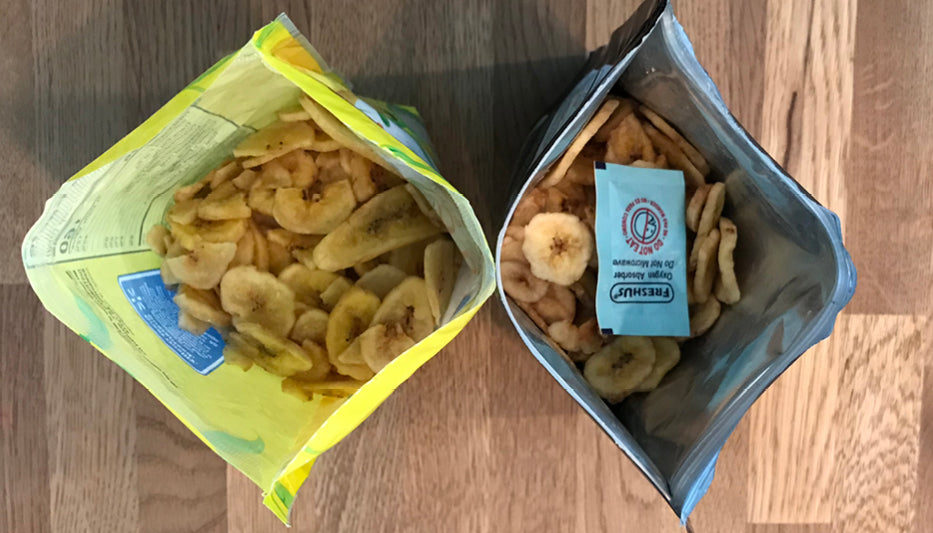
As a counterpart to our freeze-dried strawberries, here are some dehydrated banana chips. To make sure we were representing the different options at a big box store, we chose a generic, in-house brand (on the left). Ready Hour banana chips are pictured on the right. Like the name-brand strawberries, there’s no oxygen absorber inside the grocery store banana chips.

The grocery store banana chips were purchased on August 10, 2020 with a “best-by” date of January 13, 2022, giving it about a year-and-a-half shelf life after purchase.

Here are the Ready Hour banana chips. Again, the oxygen absorber sits with the food, protecting against mold and extending its life. And it shows. Compared to the one-and-a-half-year shelf life of the grocery store banana chips, this pouch will last 10 years.
MAC & CHEESE: GROCERY VS. EMERGENCY STORE
Finally, we picked up some macaroni and cheese. It may not qualify as a “dehydrated” food exactly (though the cheese powder is prepared through a “spray drying” technique) but it’s super popular option for emergency stockpiling.

The mac and cheese we chose comes from a well-known brand we’ve seen on lots of prepper shelves (pictured above on the right). As you would expect, there’s no oxygen absorber inside. What’s more, the cheese pouch is made of a paper product with lining that does little to shield against oxygen (but that could protect against moisture).

The grocery store mac and cheese was purchased on August 10, 2020 with a “best-by” date of January 29, 2021, giving it less than a year shelf life. Like the products we looked at above, lots of mac and cheese will last a ways past its date—though again, we don't advise relying on fact as you plan your emergency supply.

This is a pouch of Ready Hour mac and cheese. The first thing you'll notice is the oxygen absorber. Second, you'll see that the cheese is mixed right in with the pasta. Unlike store-bought mac and cheese, the absorber and packaging are such a protective combo that there's no need for a separate cheese pouch. This product lasts up to 25 years.
LESSONS
Our little homes test demonstrates a few things.
First, freeze-dried and dehydrated foods at the grocery store are not designed for shelf life. Everything from the lack of an oxygen absorbers to the packaging and the clearly stated, relatively short shelf life, shows that they aren’t even meant to be long-term food storage.
Second is the importance of checking the production date on grocery store items. Like we saw with the freeze-dried strawberries, because they don't last as long in the first place, half a product's shelf life can be eaten away just sitting in inventory. By the time you take it home, it may only have a few months left.
Finally, extended shelf life takes more than just an oxygen absorber. There are factors at play that like packaging that are crucial for extending shelf life.
Finally, shop like a pro. Look for multiple layers of protection.
Freeze-dried and dehydrated foods with oxygen absorbers are a good start. But when you’re on the hunt for foods that will remain fresh for a decade or longer, you need to think like a prepper and see those criteria as just a starting point—because that’s what they are.

The enemies of shelf life—oxygen, moisture, sunlight, pests, chemical leaching—are everywhere! They’ll penetrate moisture-removed foods and they’ll even slip past many oxygen absorbers.
True long-term food requires many other layers of protection. These are what you need to be looking out for when you’re shopping.
LAYER: ENOUGH OXYGEN ABSORPTION FOR THE JOB
As we saw above, unlike other manufacturers, most emergency food companies invest in placing oxygen absorbers in all of their foods. Military standards dictate that long-term food packages should contain a two-percent oxygen at most. Once you start getting to three percent and above, the chances of spoilage before the shelf-life date go way up.
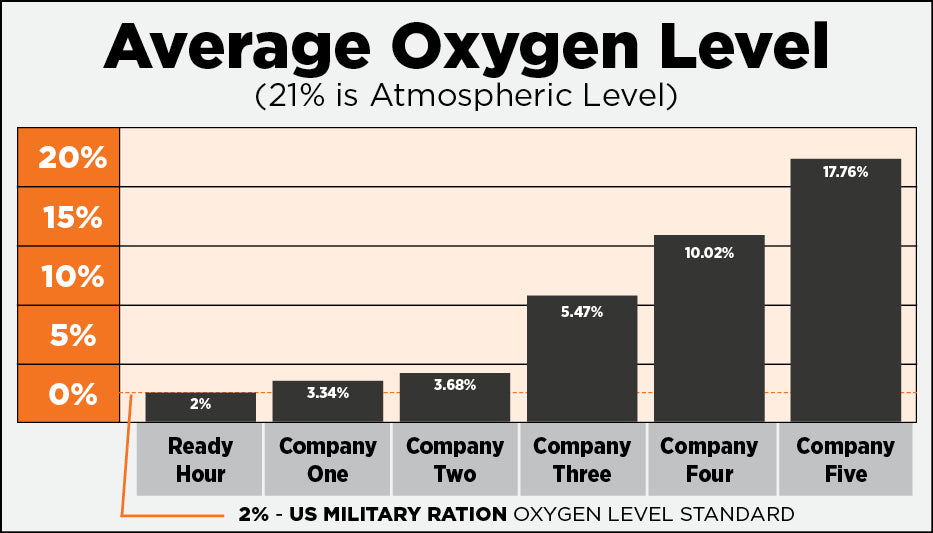
Case in point: a 2015 study found that many emergency preparation companies (even the ones that use oxygen absorbers) produced packaged foods containing well over three percent oxygen levels. Some of the very largest manufacturers had oxygen levels above 10 percent!
The problem? Their absorbers were too small to oxidize the pouches to proper levels. Oxygen is measured in cubic centimeters (cc). To get oxygen levels down to the two percent range you need an absorber large enough (enough ccs) to handle your container size.
This isn’t to say that everyone is using too-small oxygen absorbers. Mountain House has tested at or below two percent. The Ready Hour food pouches we opened also test at those levels.
Their secret—and something you’ll want to look out for when shopping for long-term food—is that they use extra-large absorbers. Ready Hour inserts 200cc absorbers into all their foods. This is double or quadruple the required size, but they’ve found that that’s what it takes to keep foods fresh for decades.
LAYER: FREQUENT OXYGEN TESTING
Unlike grocery store foods that that are made to eat quickly, long-term food producers worth their salt will invest a lot to ensure the stated shelf life of 10, 20, or 30 years can truly be met.

That’s why, in addition to investing in the right oxygen absorbers, they’ll also submit their product to regular oxygen testing. Ready Hour foods products, for example, go through rigorous testing on a weekly basis using an advanced device (the Oxybaby 6.0 headspace gas analyzer) that detects oxygen levels
The analyzer is manually inserted into either pouches or cans and within eight seconds detects oxygen levels down to .01%
LAYER: THE RIGHT PACKAGING FOR THE JOB
In the same way that the right oxygen absorber must be used, the right packaging is every bit as important for emergency food. For long-term food packaging, there are two things to look for—the quality of material and a 100% seal.
Going back to our home test, the grocery store packaging for the freeze-dried strawberries and dehydrated banana chips came in stand-up pouches made from linear polyethylene resin. These bags are multi-layer and fantastic, but they are crafted for a very specific purpose: to protect food from damage and contamination during transportation and on retail shelving.
What they aren’t made to do is to withstand the 30 years of elements, bugs, chemicals, etc. that long-term storage can be subjected to.
As we made sure to point out in the comparison pictures above, the Ready Hour packaging is made of sturdier stuff. The food is protected in a four-layer proprietary film consisting of polymer and metallic layers. This material will to stand up to all the things that grocery store packaging will not, and it shows in the significant increase in shelf life.
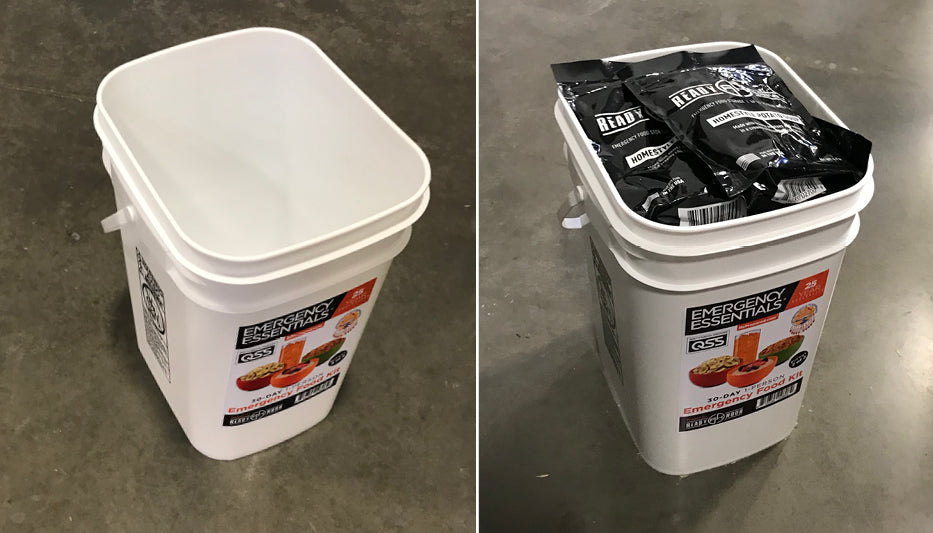
Those Ready Hour pouches, by the way, are zipper protected. On top of that, they’re almost always stored inside an industrial-grade food bucket with thick, polypropylene walls. These add an extra layer of protection that will stand up to abuse and stack easily in tight spaces.
And then there’s the #10 can—a food storage classic for a reason. For our home test we used the polymer/metallic pouches, but you’re more likely to find Ready Hour's strawberries, banana chips, mac and cheese, and most other foods in a #10 can.
When it comes to durability and multi-utility, these aren’t even in the same universe as grocery store plastic. They’re heavier and metallic, so they can take more rugged use. They also fit a lot more food per container and stack more easily.
And then there's the cost—this might surprise you
In our analysis, there’s one thing that hasn’t been touched on yet that I know we’re all thinking about: the cost. Between extra-large absorbers, oxygen testing, and polymer metallic packaging, it’s easy to imagine how the price of emergency food could quickly eclipse its grocery store counterparts.
And yes, freeze-dried and dehydrated foods made by emergency manufacturers are generally more expensive than what you’ll find at the grocery store. But when you do the math, the cost difference isn’t as significant as you might think.
UPFRONT COST
Lots of times when you hear complaints about the cost of emergency food versus grocery store food, you’re looking at upfront costs.
Those Strawberries from our test, for example? They cost $3.48 per pouch.
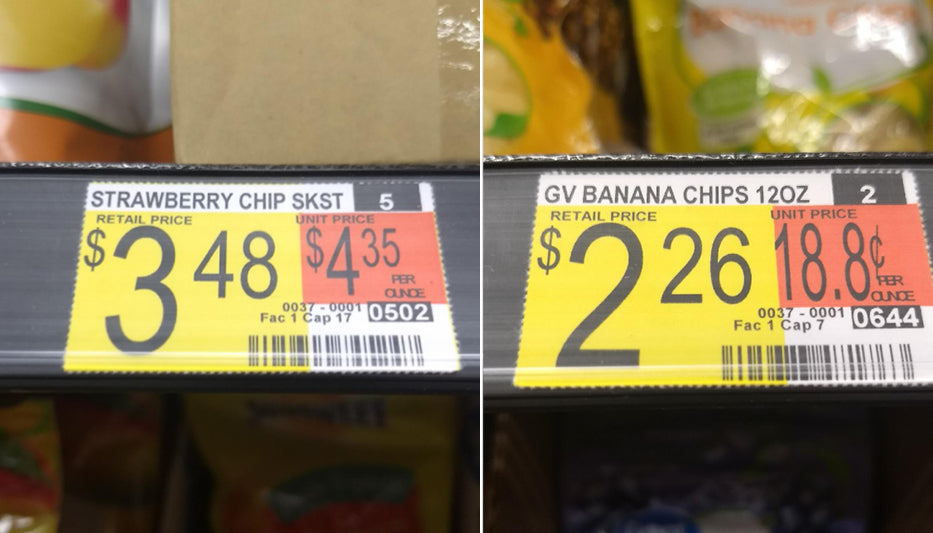
For comparison, the Ready Hour freeze-dried strawberries we sell in a #10 can on BePrepared.com retail for $30.
At first glance that’s a big difference, but it’s not the whole story.
LONG-TERM COST
Even though a #10 can of Ready Hour strawberries costs a lot more than the grocery store pouches, it also gives you seven to eight times the amount of fruit in a single package.
Another way to put it is the grocery store strawberries cost $4.35 per ounce, while the Ready Hour strawberries cost about $4.75 per ounce.
So, are the emergency strawberries more expensive? Yes. But if you break down the cost, it’s not by much. And if you take into account all those extra layers of protection the value starts to add up.
Plus, don’t forget: with grocery store food you have to rotate out items that go bad and replace them on a regular basis. It’s a headache, and the costs start to pile up. As a one-time purchase, emergency store food pays you back pretty quickly and is actually the least expensive option in the long run.
Conclusion
If it’s not clear by now, when it comes to long-term storage, standard grocery store food just cannot compete with the products you'll find through emergency suppliers.
This makes all the sense in the world, when you think about it. Grocery store foods, even the freeze-dried and dehydrated foods varieties, are made to eat quickly. 99 percent of shoppers don’t need those foods to last for more than a few weeks, which means manufacturers have no incentive to make the investments that emergency companies do—like configuring a production line to drop oxygen absorbers into every package or investing in more durable pouches and cans.

Emergency food manufacturers, on the other, make those investments, and they pay off in the long run.
Ultimately, even though they might look the same to the untrained eye, grocery store foods and emergency foods are very different products. If you’re looking to invest your time and money in supplies that will last many years and prepare you for disaster, there’s really only one option, and that’s true emergency food.

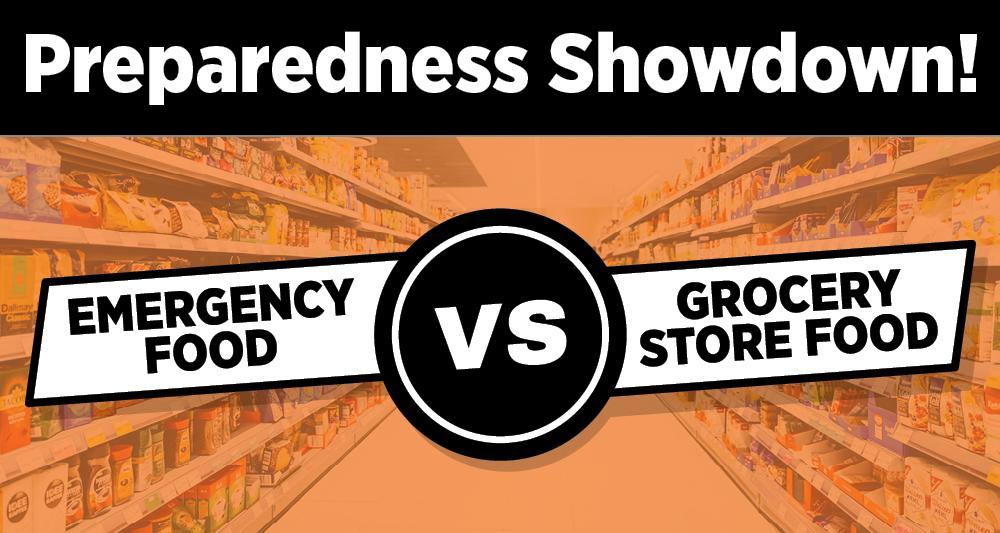
22 comments
Robbie Graves
Sendanythevthing free
Mark Cundiff
A few years back yall offered the “SuperPailCombo” it was a do it yourself food storage kit. I purchased a couple of these and loved them. They were great for dry beans, rice… I could buy commodities in bulk and save by packing them myself. Can you provide the new catalogue number for the kits. Im having trouble finding them. ~Thank You
Jim S
I orginally began “prepping” around 2000 mainly in case of Weather emergencies as My area is In the Northeast and we have occasional Blizzards/Winter storms of intensity and flooding ( shoreline) as well as Occasional serious Hurricanes, NorEasters’ to name a couple I’d Purchased a few mountain house meats to add to my "regular short term stores having been raised By parents and Grandparents who survived the depression era and even raised 11 kids in My father’s side ( I cant even imagine) He Became the Head of the Meat department In our Local A&P store for near 40 years we had an upright and chest style freezers that were Amazing in what they had in frozen food alone…. In 1960-61 The Eastern Seaboard suffered a Blackout that lasted several days I recall with Electric STove we ended up cooking in one of 2 fireplaces we had in a Brand new 3 bedroom ranch They moved into Memorial Day weekend, someone as a House warming gift Gave them a NEW Grill designed with a single pole Tol to bottom and the grill swiveled IN over the fire and back out… It was fine for burgers and dogs and steaks and chicken parts etc and we ate warm food at least … used the fire for light and warmth and got through 3 or 4 days and nights without power… MY Dad’s Learned lesson was To go out and Buy a Used small apartment sized 4 burner oven Gas stove, Placed it In a spot in the Basement and Ran a Gas line out to the Propane Bottles outside… Hindsight is always 20-20 as they never really used the stove as it was, in emergency only a couple times they had Parties in the Family room and it was used to heat meatballs or similar…. with Time I moved downstate and to another career and life in 2012 I was thankful I’d been raised with common sense Depression era Parents as I was Living in an apartment less then a 1/4 Mile from Long Island Sound when Hurricane Sandy came ashore ( that was the one that hit NYC and The Barrier Islands Off southern Long Island in Brooklyn and queens as well as towns Outside the 5 boros trailed the 40 miles across the island and Long Island sound and slam Our SHORE as well I had Friends and Neighbors less then a 1/4 Mile from me who had Serious damages NO power for weeks while I had The Lights flicker 3 or 4 times But I never fully lost power , a couple of months later We Had a Blizzard in which we recieved 3-4 feet of snow in about 28 hours being “ON the shoreline” we typically get a dusting and 2 miles inland gets hammered Thankfully I’d Gone To the store Prior to the Milk and eggs and bread People and stocked up even bought a couple of Longer term meal ideas such as stuff to build a nice Beef stew for a couple or 3 days worth…. I began getting More serious just prior to the Pandemic Hitting Hard I placed a couple orders with Both Be Prepared EE, and Ready hour My original thinking was case packs from Ready hour I’d bought a half a dozen From EE ( single packs) I still Have some FD Pineapple green beans Corn and well The chicken I tried and found it was awesome Then The pandemic hit and Single packs disappeared ..lol Over Time I’ve been adding Items Monthly on a fixed retired income in a rented apartment I’ve Built up easily a couple months worth of Food in the Freeze dried section as well as A Great relationship with a couple of eBay sellers who have various canned Meats at a “today reasonable” price… I do have some Freeze dried Beef, chicken, Sausage crumbles and Ground beef as well that I thankfully caught before Pandemic prices… Folks IF They dont offer specific items cooked how you Need it cooked , Feel free to also Look up food preparation, CANNING as well as Prepper Pantries HOW to videos and Learn How with a Little Expense and Time set aside anyone can learn the art of Storing food, for “longer” terms on your shelf 3-5 years Perhaps More under the right conditions…. Lots of Great shared information On You Tube and other venues too … But I’d Like to give thanks to folks like these AT Be Prepared Emergency essentials, and Ready HOUR for doing what they do in tiding us Over with They’re food offerings as well as they’re survival supplies and tricks and hint and tips and willingness to share this knowledge for anyone who wants to Listen and prepare Thanks Y’all
Anita Oleksy
Would opened cans last longer with EXTRA oxygen absorbers, say, taken from other, used-up cans?
BePrepared
To answer your question, Donna, no, we cannot substitute items in the #10 can kits. You could put the kit of cans you’re describing together yourself. It would be a bit more expensive, but you’d get exactly what you want. Hope that helps!
BePrepared
AudreyNuti, good questions. I can tell you that our foods are sourced from the US and Canada. There is a complete list of ingredients on every nutrition label. For the most part, you can find these on the pages for each individual product.
Glad you asked about the gluten-free foods! We actually carry an entire gluten-free kit with tons of delicious foods. You can find it here: https://beprepared.com/products/z_legacy_zf_nogluten_gluten-free-kit?pos=1&_sid=71391c13d&ss=r
BePrepared
To the questions about what to do with a can that’s been opened, we recommend closing it back up with the lid and oxygen absorber and then storing it in a cool, dry place between 55 and 70 degrees. Depending on the content of the can, the food can last for up to another year that way.
If you want even more protection for your opened food, there are customers who vacuum seal opened food. That should extend the life even more.
BePrepared
Great questions all!
To Marjann, Buck, and AudreyNuti. We are currently carrying case packs of Black Bean Burgers that I think would fit what you’re asking for. You can find them here: https://beprepared.com/products/z_legacy_76_black-bean-burger-mix-case-pack?pos=1&_sid=f45f871c6&ss=r
Donna Lauber
Can you make customized packages?
Example breakfast emergency offering
We don’t use tomatoes or mushrooms in our omelettes. Could you substitute scrambled eggs and cheese instead or more onions and bell peppers?
AudreyNuti
I would also like smaller cars. Just me. Is any of your food grown without chemicals? Is there any site where I can see the contents of you meals? Are any gluten free?
Buck
I agree with the lady who posted on 11/20…
A large container is fine for a when its several people but what about those that desire a smaller portion? What happens to the large portion once it’s open and not completely used?
Marjann Warren
It would be better to offer smaller cans for older people whose children are grown and out of the house. My husband and I cannot eat the amount in the #10 cans once they are opened in a timely manner.
BePrepared
Great question, Lee. You’re right that freeze-dried foods maintain their nutrition (and taste) better than other preservation methods.
As for what’s listed on the label, there are a couple things to keep in mind.
First, no label will list all nutrients—some are going to be left off. If you’re interested in knowing the complete nutritional profile of a food, try a website like healthline.com or nutrition.gov. They’ll tell you most of what you want to know.
Second, serving sizes can vary on nutrition labels. This can make it appear as if a food has fewer nutrients than it ought to.
Hope this helps!
Lee S
I wanted to start storing long-term food that has a dense nutrition. But when I look at the freeze dried food labels, it looks as though all the nutrition is gone. If freeze dried foods hold their nutrition, why do their labels not reflect this?
Susan Hansen
Do you have a gluten-free line of prepared foods??
Mar Bly
This is excellent content As a Ph.D. retired, I can tell you that no one has put out information like this. Thrive does the food as immediately as is humanly possible and makes usually single food cans (I prefer these) Other companies say they are organic. But, do not give you any of this info. I am printing this off so I can explain to others why the high price is not so high.
QUESTION: I have almost 10 year old #10 cans stored. Did they have the extra O2 absorbers – I f.d. at home and always put more O2 absorbers in that I think it needs.
Any info on pests and mylar bags???
Emergency Essentials
Good question, Raymond. One of the first things to focus on when planning how much food per person is calories. Usually for an adult, you’re going to want to be somewhere between 1,800 and 2,200 calories per day. Beyond that you want to look for foods that are complete as possible in nutrients: fats, carbs, and protein are very important in an emergency.
Emergency Essentials
Thanks for asking, Ruth. BePrepared.com carries a variety of products. A good place to start searching is here: https://beprepared.com.
Ruth Perkins
W here do I find your products
Raymond
I would like to know the formula for how much food per person per day
max
This is true. I bought some freeze dried refried beans from the store. They went rancid in a few months.
Lynda
Please start making prepared foods again. I’ve purchased a lot of prepared meals from you but haven’t seen any this year.